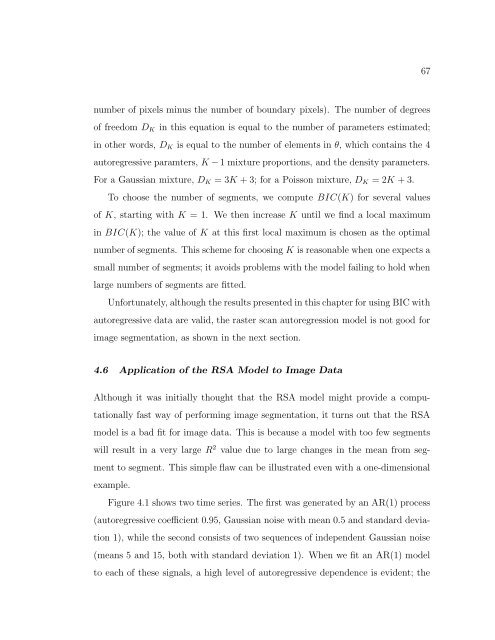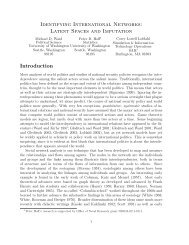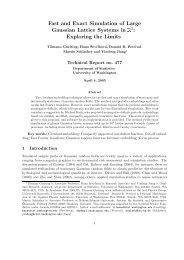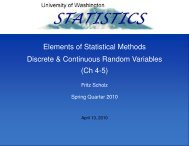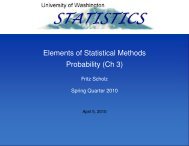View - Statistics - University of Washington
View - Statistics - University of Washington
View - Statistics - University of Washington
Create successful ePaper yourself
Turn your PDF publications into a flip-book with our unique Google optimized e-Paper software.
67number <strong>of</strong> pixels minus the number <strong>of</strong> boundary pixels). The number <strong>of</strong> degrees<strong>of</strong> freedom D K in this equation is equal to the number <strong>of</strong> parameters estimated;in other words, D K is equal to the number <strong>of</strong> elements in θ, which contains the 4autoregressive paramters, K − 1 mixture proportions, and the density parameters.For a Gaussian mixture, D K = 3K + 3; for a Poisson mixture, D K = 2K + 3.To choose the number <strong>of</strong> segments, we compute BIC(K) for several values<strong>of</strong> K, starting with K = 1. We then increase K until we find a local maximumin BIC(K); the value <strong>of</strong> K at this first local maximum is chosen as the optimalnumber <strong>of</strong> segments. This scheme for choosing K is reasonable when one expects asmall number <strong>of</strong> segments; it avoids problems with the model failing to hold whenlarge numbers <strong>of</strong> segments are fitted.Unfortunately, although the results presented in this chapter for using BIC withautoregressive data are valid, the raster scan autoregression model is not good forimage segmentation, as shown in the next section.4.6 Application <strong>of</strong> the RSA Model to Image DataAlthough it was initially thought that the RSA model might provide a computationallyfast way <strong>of</strong> performing image segmentation, it turns out that the RSAmodel is a bad fit for image data. This is because a model with too few segmentswill result in a very large R 2 value due to large changes in the mean from segmentto segment. This simple flaw can be illustrated even with a one-dimensionalexample.Figure 4.1 shows two time series. The first was generated by an AR(1) process(autoregressive coefficient 0.95, Gaussian noise with mean 0.5 and standard deviation1), while the second consists <strong>of</strong> two sequences <strong>of</strong> independent Gaussian noise(means 5 and 15, both with standard deviation 1). When we fit an AR(1) modelto each <strong>of</strong> these signals, a high level <strong>of</strong> autoregressive dependence is evident; the


